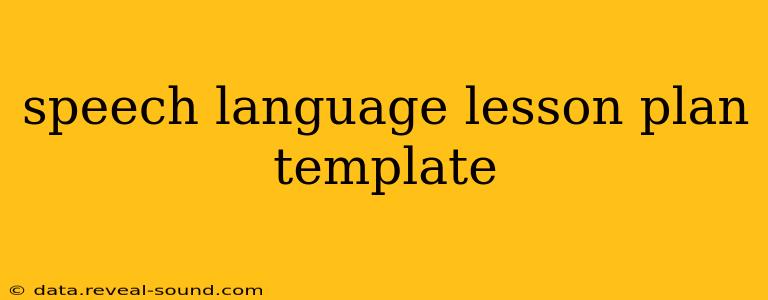This template provides a structured approach to creating effective and engaging speech-language therapy lesson plans. It's designed to be adaptable for various ages and skill levels, focusing on clear objectives, engaging activities, and thorough assessment.
I. Student Information:
- Name:
- Date of Birth:
- Diagnosis: (e.g., Articulation Disorder, Fluency Disorder, Language Disorder)
- Grade/Age:
- Goals (Long-Term & Short-Term): Clearly state the overarching goals and specific, measurable, achievable, relevant, and time-bound (SMART) short-term goals. Examples:
- Long-Term: Improve expressive language skills to facilitate successful social interaction.
- Short-Term: Increase the use of complete sentences from 50% to 75% during conversational speech by [Date].
II. Lesson Overview:
- Date:
- Theme/Topic: (e.g., Describing Objects, Following Directions, Telling Stories) Relate this to the student's interests whenever possible.
- Focus Area: (e.g., Articulation of /s/ and /z/, Verb Tense, Narrative Structure) Specify the target speech or language skill.
III. Materials:
List all materials needed for the session, including visuals, manipulatives, technology, and any worksheets or handouts. Be specific (e.g., "Picture cards of fruits," "Articulation cards with /s/ blends," "iPad with speech therapy app").
IV. Procedure:
This section outlines the step-by-step activities of the lesson. Use clear and concise language. Include:
-
Warm-up (5-10 minutes): A brief activity to engage the student and prepare them for the lesson. Examples include:
- Articulation: Tongue exercises, blowing bubbles.
- Language: Singing songs, reviewing vocabulary.
- Fluency: Relaxation exercises, rhythmic breathing.
-
Activity 1 (15-20 minutes): This is the core activity targeting the specific skill. Include:
- Objective: State the learning objective for this activity.
- Materials: Specify the materials used.
- Procedure: Describe the steps involved in detail. Include prompts, cues, and modeling as needed.
- Data Collection: Explain how you will track the student's progress (e.g., number of correct responses, percentage accuracy, duration of fluent speech).
-
Activity 2 (15-20 minutes): A second activity reinforcing the target skill, possibly using a different modality or context. Follow the same structure as Activity 1.
-
Wrap-up (5-10 minutes): Summarize the lesson, review key concepts, and provide positive reinforcement.
V. Assessment:
- Pre-assessment: What assessment was conducted before the lesson to establish a baseline?
- During-assessment: How was progress monitored during the activities?
- Post-assessment: How will you assess the student's learning at the end of the lesson? This might involve a brief quiz, observation of performance, or review of collected data.
VI. Modifications/Adaptations:
- If needed, describe any modifications or adaptations to the lesson plan to meet the student's individual needs. This could include changes to the materials, activities, or level of support.
VII. Home Practice:
- Suggest activities for the student to practice at home. This ensures consistency and generalization of skills.
VIII. Reflection:
- After the lesson, reflect on the effectiveness of the activities, the student's progress, and any areas for improvement in future sessions. Consider what worked well, what could be improved, and how the lesson could be adapted for future sessions.
Example Incorporating "People Also Ask" Questions:
Let's say the focus area is improving narrative skills. "People Also Ask" questions might include:
-
How can I help my child tell better stories? (This would be addressed in the "Home Practice" section with specific suggestions like prompting details, using story starters, and encouraging sequential recounting of events.)
-
What are the key elements of a good story? (This would be integrated into Activity 1, perhaps using a visual organizer to guide the student in identifying characters, setting, plot, and resolution.)
-
How do I teach storytelling to preschoolers? (This would inform the choice of activities and materials, using simpler language and more hands-on, playful approaches.)
-
What are some fun activities to improve storytelling skills? (This would shape the choice of Activity 2, potentially involving puppets, dramatic play, or picture sequencing games.)
By consistently using this template and thoughtfully incorporating relevant questions from search engines, you can create highly effective and targeted speech-language therapy lesson plans that are both engaging and result-oriented. Remember to adjust this template to fit the specific needs of each individual student.
